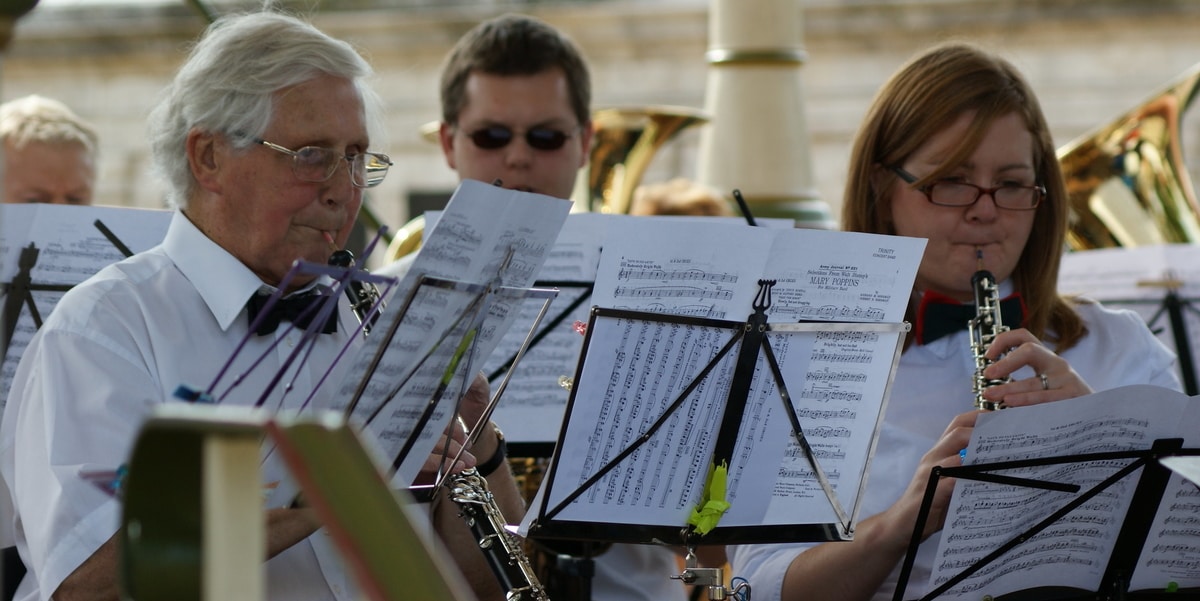Every musical instrument requires tuning. As a player, you might have questions for why this is important, and how to do it.
In this article, we'll discuss oboe tuning, how it works, why it is vital, and how to improve your ability to tune.
Why is Tuning Important?
Have you ever listened to a performance and found yourself cringing?
In all likelihood, the performer was playing their instrument out of tune. That’s why we spend so much time learning how to play in tune, and doing exercises that will help up improve our ears.
We wouldn’t want to be the person on stage playing something horribly out of tune, and making our audience members cringe!
Playing in tune has many benefits like preventing cringing. Okay, there are some actual concrete reasons. You sound more resonant, you can sound louder, you can more accurately communicate what the composer wanted, etc.
Why Does the Oboe Tune the Orchestra and Band?
This is a question that often comes up. There are a few main reasons for why the oboe gives a reference pitch for ensembles.
One reason comes from the history of orchestras. The oboe played a prominent roll in orchestras early on when they were introduced into the ensemble. In orchestra’s early history, the oboe was a featured soloist, which is the same as many modern-day orchestras.
Another reason is the distinct timbre that the oboe has is able to cut through the sound of an entire orchestra relatively easily. While tuning is generally split up into smaller groups of like instruments, the sound of an oboe can outplay an entire brass section if done correctly.
The last and arguably most important reason is that there are no tuning slides on the oboe. In fact, there isn’t even an ability to adjust things, unless you are going to scrape on the reed itself.
An oboe reed was made to be pushed all the way in. Under no circumstances should the reed be pushed in or pulled out. The oboe is not the same as a clarinet or something of the like - the only adjustments of tuning can be made with the embouchure, airstream, and reed scraping.
Do not let anyone tell you to push in the reed or pull it out. That is not how the oboe works. Because of its relatively consistent form and stable tone, it’s a perfect fit for holding a reference pitch.
What Are the Ways That Pitch Can Be Affected?
Pitch can be affected in many different ways. Some of these things can be controlled, and others can’t.
Amount of Reed in Mouth
One of the ways that you can affect intonation is the amount of reed in the mouth. This is similar to the idea of pushing in a mouthpiece or pulling it out.
Think of it this way: the shorter the length the higher the pitch, your example of this is a piccolo. The longer the length the lower it gets, your example being the tuba.
There is a massive amount of tubing that makes the tuba what it is, and very little tubing that makes up the piccolo. If you have more reed in your mouth, the shorter the tubing and the higher the pitch. If you decide to have less reed in your mouth, the longer the amount of tubing, and the lower the pitch.
Embouchure
Your embouchure also has a great deal to do with the intonation of your instrument.
When you tighten your embouchure, the pitch rises. When you loosen your embouchure, the pitch falls.
This, along with air support, are your main ways of controlling intonation. When someone asks you to pull out your reed or push it in, you can respond by simply adjusting your embouchure and air support.
Remember, do not ever pull out your reed or push it in! Your reed is meant to be placed all of the way into the reed well.
Air Support
Your air support is essential to your success as an instrumentalist. Not only will the correct air support help your tone, but it also greatly affects your intonation.
Often times as young oboists, the air support is not there, so they compensate with tightening up their embouchure. This is something that should be avoided at all costs - you will end up having to do significant work fixing your embouchure later on.
Instead, let’s focus on having solid air support. What does that really mean though?
Have you ever watched someone play an instrument, and their shoulders move up and down when they breathe in? That is an example of bad air support.
In both singing and playing a wind instrument, you want to shift your breathing down to your diaphragm. Your stomach should expand all the way around - including your sides and back.
If your shoulders move up and down, that is a great indicator that your breathing is rather shallow, and remaining in your chest.
What does this have to do with intonation?
Well, if your air support is poor, the pitch falls. With that being the case, that’s why many young oboists tighten their embouchure because that raises the pitch. When your air support strengthens, the pitch rises. Your embouchure will have to be looser to accommodate that.
As you can see, embouchure and air support are so intertwined - it’s a constant balancing act between the two.
Reeds
Your reeds can also affect intonation. As a beginner, I would say that this doesn’t particularly matter. Just focus on air support and embouchure!
For the more advanced student, this is a place where you can adjust your reed with a reed making kit.
Learning how to make oboe reeds will inform your decisions on how to bring the pitch up or down without entirely changing the tone and responsiveness.
In short, the same principles of intonation apply to an oboe reed. The shorter you make the reed, the higher it gets. However, the amount of cane on the tip must also be taken into account.
The more cane you take off the tip will flatten the pitch. That’s why the balancing process of reed making consists mainly of thinning and clipping the reed.
As a player, you might be playing on a reed that doesn’t fit your anatomy, where your embouchure lies, air support, etc. Sometimes a switch in the type of reed you are buying can make all the difference.
Temperature
One thing that you don’t have entire control over is the temperature. If your instrument is cold, it will be on the flatter side. Naturally, as the temperature rises, so does the pitch.
This brings along the importance of warming up properly. Your instrument’s pitch will change until it hits the peak temperature (where it will stay for long periods of playing).
If you are insufficiently warmed up, your pitch will continue to rise, which can be unpredictable.
All of that being said, your oboe shouldn’t be exposed to extreme temperature shifts. Especially if you have a wood instrument, extreme temperatures can cause serious damage.
For example, I live in Minnesota. I would never leave my oboe in the car in the middle of winter (or ever for that matter) because the extreme cold would be bad for the instrument. Extreme heat is also bad.
In general, keep your instrument in a temperature-controlled environment. This could be your house, a locker at school, etc. Just don’t leave it somewhere like a car or the great outdoors.
What Are the Tendencies of Certain Tones?
There are also certain pitches, as with every type of instrument, that sit sharp or flat.
These are notes that you need to be aware of as a player, so that you can get used to adjusting before it’s a problem.
In general, the third octave sits sharp, and the lowest octave sits flat. Here are examples of notes and their tendencies on the oboe:
Sharp: G#/Ab5, A5, Bb5, Eb6, E6
Slightly Sharp: E4, F4, F#4, G4, G#4, C#5, D5, F5
Flat: Bb3, B3, C4, C#4, D4
Your oboe and make of oboe can affect the pitch as well. In addition to if your oboe is in or out of adjustment.
In other words, you need to get to know your instrument. I would suggest doing a pitch tendency chart that marks where each pitch wants to naturally lie. That way, you can see what adjustments you will need to make based on your oboe.
To create a pitch tendency chart, write down all of the pitches that are in your range. Then, with a tuner, play each note without adjusting. Mark down exactly where the pitch wants to sit, for example, it might want to sit two cents flat.
In order to do a pitch tendency chart, you will need a tuner. Having a tuner is an essential part to being an oboist. As mentioned earlier in the article, you will most likely be asked to tune your ensemble at some point in your playing career.
You might ask, why do I need an actual tuner when I could just have one on my phone? Well, number 1, you can’t have a phone on stage.
More importantly, it’s a good idea to stay away from having your phone with you while you are practicing. Phones can be very distracting, so taking that aspect out of practicing will make your practice sessions more effective and efficient.
How To Improve Your Ear
It’s important to note that you can’t play with a tuner on all of the time. You have to build your ear and your ability to adjust your intonation to those around you. It’s an important skill to have as a musician!
How can you improve your ability to match pitch?
One exercise that I love to do while I’m warming up is playing scales with drones. If I’m playing a D major scale, I will put a drone on that is the pitch of D. I find my drones on youtube - all you have to look up is _ drone, depending on what note you want!
You play the scale over this drone and then work on tuning your intervals. Your ear will improve astronomically by doing this exercise.
Another exercise is simply playing with another person. I like to make it a game where I try to fit my sound into the person I’m playing with.
By doing this, I subconsciously focus my ears on their tone and intonation. I improved a lot as a musician by focusing on this.
You don’t even need to be playing the same part to do something like this. You could spice it up a bit and play duets or trios. Chamber music is so much fun and helps you to grow as a player all around. I would highly suggest getting a group of people together and playing some chamber music!
Closing
Tuning your instrument is a vital part of being a successful musician. With this new-found knowledge and/or simple reminders, take small steps towards improving your ear and your accuracy in tuning.
Make small goals for yourself - those are always the most achievable and worthwhile. Happy tuning!






